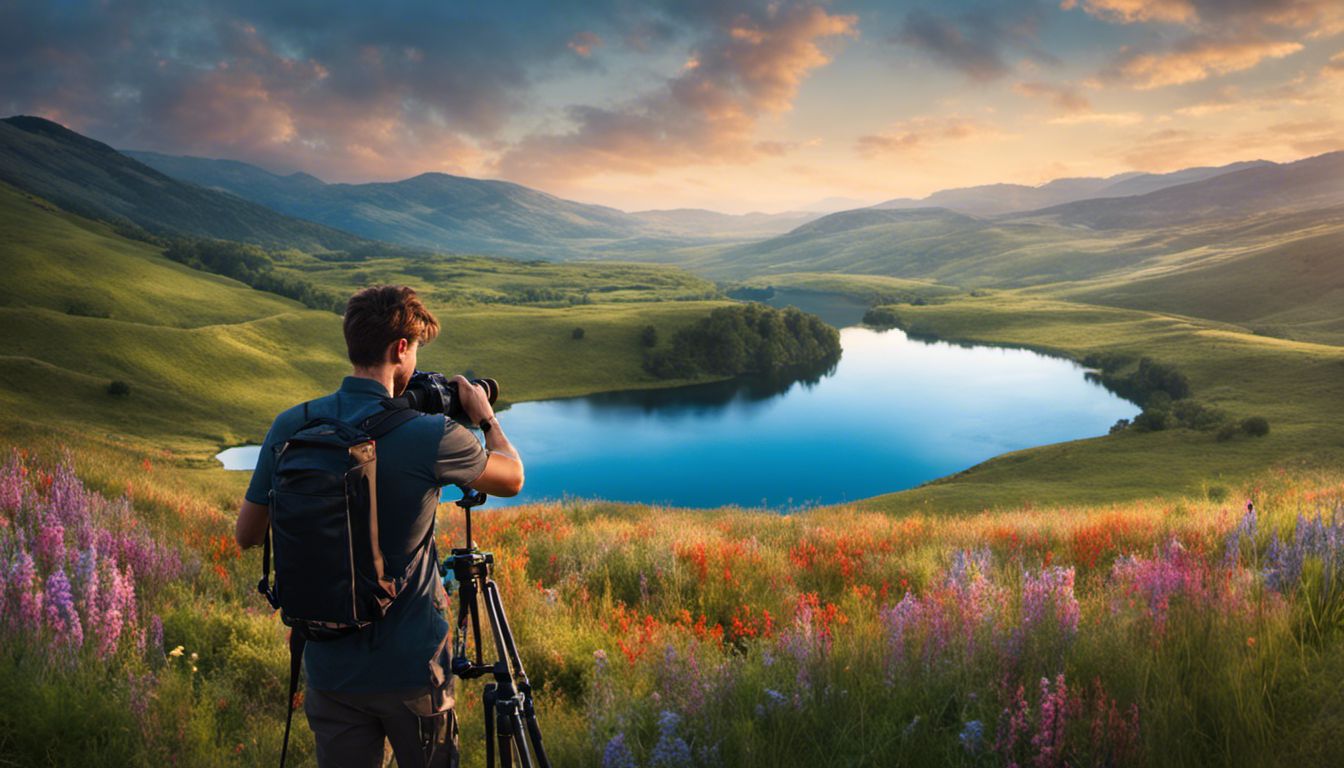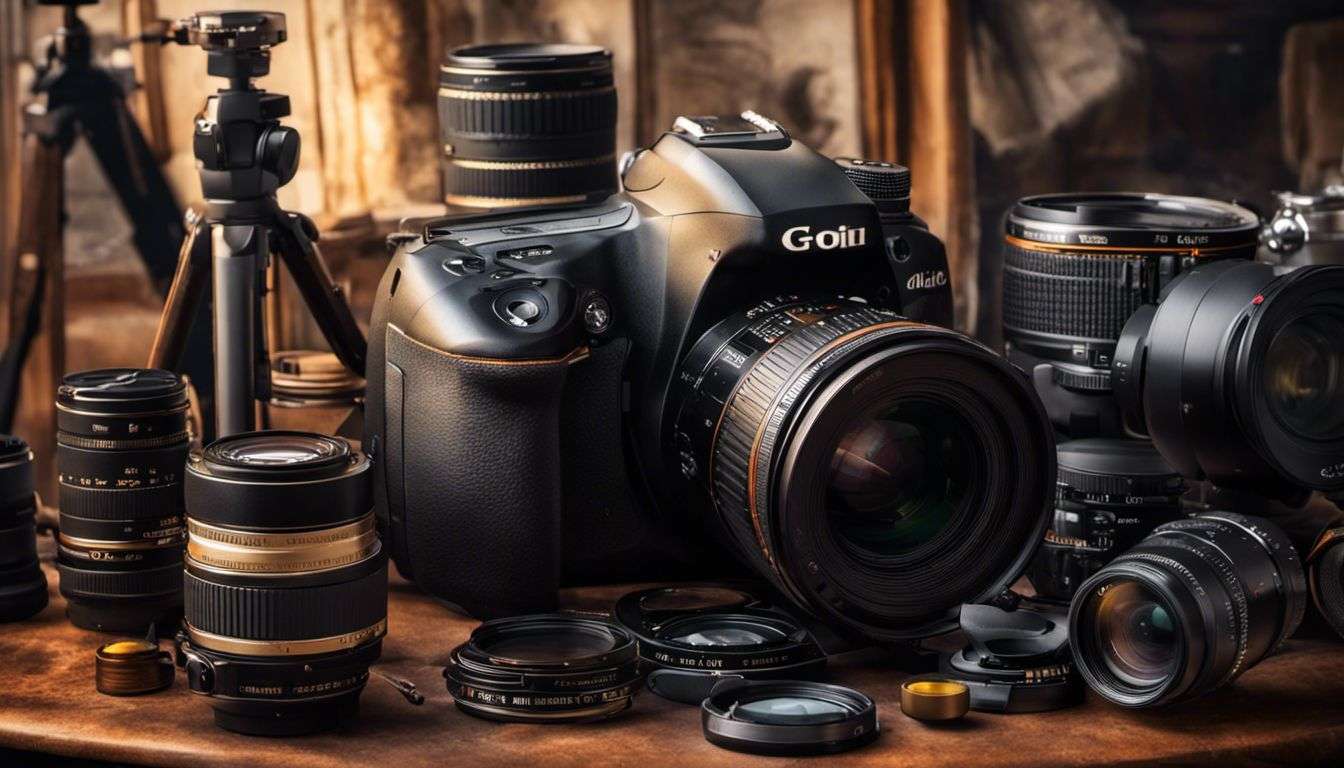Are you puzzled on how to take your videography skills to the next level? Videography, an art that blends technical skills with creativity, plays a crucial role in various domains such as filmmaking and social media content creation.
Our article simplifies the process by breaking down complex concepts into easy-to-understand methods and practical tips – equipping you with everything you need to master videography.
Ready for your journey into captivating visual storytelling? Let’s dive in!
Key Takeaways
- Learn the importance of research in videography, including understanding current trends and styles, and exploring shooting locations.
- Equip yourself with the right gear such as a high – quality camera, lenses for different perspectives, good lighting equipment, microphones for clear audio recording, and video editing software.
- Plan your shoot by developing a concept, writing a script, scouting locations, scheduling shoots, preparing shot lists and backup plans.
- Tell a compelling story through videography by having a clear idea of what you want to convey and using techniques like interviews, voiceovers, visuals, composition techniques like leading lines.
Understanding the Fundamentals of Videography

Research, gather equipment, plan your shoot, tell a story, compose and frame shots, control lighting and sound, and explore different camera movements for effective videography.
Research
Effective research involves examining the types of videos that are popular in your chosen field. This can help you understand current trends, styles and techniques. Look to established videographers for inspiration while also seeking out opportunities to define your own unique style.
Investigating various shooting locations is important too, as it can majorly impact the aesthetics of your video. Finally, keeping up-to-date on technological advancements in equipment and editing software will enable you to produce high-quality content with cutting-edge features.
Gathering Equipment
Equipping yourself with the right videography gear is a critical step towards mastering the craft.
- Start by getting a high – quality camera suitable for videography.
- Invest in lenses that offer various perspectives and depth.
- Purchase a sturdy tripod for stability during shoots.
- Don’t overlook importance of good lighting; consider buying reflectors and softbox lights.
- High – quality microphones ensure clear audio recording.
- Spare batteries and memory cards are vital for long shooting sessions.
- A backpack or case protects your equipment while providing easy mobility.
- Consider action cameras or drones for unique angles.
- Video editing software is needed for post – production enhancement.
- Accessories like filters and lens hoods can improve video composition.
Planning Your Shoot
Effective videography requires thorough preparation and planning. Here are the crucial steps to follow:
- Develop a Concept: Brainstorm ideas that align with your video’s purpose and its target audience. This is where storytelling in videography comes into play.
- Write a Script: Detail out every scene, including dialogues, actions, and camera angles. Tools like storyboard software can be beneficial here.
- Scout for Locations: Explore different locations for your shoot, keeping in mind factors such as lighting conditions and noise levels.
- Schedule Your Shoot: Determine the best time to shoot at each location based on factors like natural light or crowd control.
- Plan Your Equipment: List down all necessary tools such as cameras, tripods, audio recording devices or drones needed for the shoot.
- Prepare shot list: Organize every shot you intend to take during the shoot; this includes primary footage and Broll footage.
- Rehearse: Practice scenes before shooting to reduce mistakes and improve camera stability during the actual take.
- Backup plan: Have contingency plans in place for unexpected issues like weather changes or equipment malfunctions.
Telling a Story
Telling a story is the heart and soul of videography. It’s about capturing moments that evoke emotion and engage viewers. To effectively tell a story, you need to have a clear idea of what you want to convey and how you want to convey it.
Think about the message or narrative you want your video to have, whether it’s a personal experience, an event, or showcasing a product or service. Consider using different techniques such as interviews, voiceovers, or visuals to bring your story to life.
By carefully crafting your shots and sequencing them in a meaningful way, you can create a compelling narrative that resonates with your audience without relying on dialogue alone.
In videography, storytelling goes beyond just filming events; it’s about capturing authentic moments that unfold naturally. Pay attention to details that enhance the story you’re trying to tell – from close-ups of facial expressions to wide-angle shots that capture the atmosphere of the scene.
Use visual elements such as color schemes and composition techniques like leading lines and rule of thirds to guide the viewer’s eye through your video and highlight key elements within your frame.
Remember that every shot should serve a purpose in telling your story – each frame should contribute something valuable rather than being filler footage.
When editing your footage together, consider pacing and rhythm as important components of storytelling in videography. Experiment with transitions between shots such as cuts or crossfades to create smooth flow throughout your video presentation.
Music can also play an integral role in setting the mood for different scenes or conveying specific emotions – choose music carefully based on how it complements and enhances the overall narrative.
Composition and Framing
Good composition and framing are essential in videography to create visually appealing videos. When composing your shots, consider the rule of thirds, where you divide the frame into three sections horizontally and vertically, placing your subject along these lines or at their intersections.
Utilize leading lines to draw viewers’ eyes towards the main focus of the shot. Experiment with different angles and perspectives to add depth and interest to your videos. By using techniques like close-ups, wide shots, and Dutch angles, you can evoke different emotions and create a dynamic visual experience for your audience.
Remember that proper framing helps guide viewers’ attention within the frame and enhances the overall storytelling in your videos.
Lighting and Sound
Proper lighting and sound are essential elements in videography to create high-quality videos. When capturing footage, it is important to ensure that your subject is well-lit to avoid dark or grainy images.
Additionally, using appropriate lighting techniques can enhance the mood and atmosphere of your video. It’s also crucial to pay attention to sound quality by using a microphone or audio recording device to capture clear and crisp audio.
By focusing on these aspects, you can elevate the overall production value of your videos and engage your viewers more effectively.
Camera Shots and Movements
Camera Shots and Movements are crucial elements in videography. They add depth and visual interest to your videos. Here are some techniques you can use:
- Establishing shot: It sets the scene by showing the location or the surroundings.
- Wide shot: It captures the entire subject and its surroundings, giving context to the scene.
- Medium shot: It focuses on the subject from the waist up, allowing viewers to see facial expressions and body language.
- Close-up shot: It highlights a specific detail or feature of the subject, creating intimacy and emphasizing emotions.
- Tracking shot: It follows the subject’s movement, providing a dynamic perspective.
- Pan shot: It moves horizontally from one side to another, capturing a wider view of a scene.
- Tilt shot: It moves vertically either up or down, revealing something above or below the frame.
- Dolly shot: It involves moving the camera closer to or farther away from the subject while maintaining focus, creating a smooth and controlled movement.
- Crane shot: It uses a crane or similar equipment to achieve high-angle or aerial shots, adding drama and scope to your videos.
- Steadicam shot: It involves using a stabilizing device attached to the camera operator’s body for smooth handheld shots without shaking.
- Zoom shot: It changes the focal length of the lens while keeping the camera stationary, magnifying or minimizing a subject within the frame.
Tips for Capturing Professional-Looking Videos

Learn how to make your videos look more polished and professional with these essential tips. From proper lighting and exposure to using angles and camera placement effectively, you’ll discover the secrets to capturing stunning visuals that will captivate your audience.
Show, Don’t Tell
To create visually captivating videos, it’s important to show rather than tell. Instead of simply narrating or explaining everything to your viewers, let your visuals do the talking.
Use compelling images, actions, and scenes to convey your message effectively. Show the emotions, experiences, and stories through well-framed shots and dynamic camera movements. By focusing on visual storytelling techniques, you can engage your audience and make a lasting impact with your videography skills.
Proper Lighting and Exposure
Proper lighting and exposure are essential elements in videography that can greatly enhance the quality of your videos. Good lighting helps to set the mood, create depth, and draw attention to specific areas or subjects within a frame.
It’s important to understand how different lighting techniques can affect the overall look and feel of your video. Experimenting with natural light, artificial light sources, and diffusers can help you achieve the desired effect.
Additionally, understanding proper exposure ensures that your video is neither too dark nor too bright, maintaining clarity and detail in every shot. By mastering the art of lighting and exposure, you can capture professional-looking videos that engage and captivate your audience from start to finish.
Use of Angles and Camera Placement
To capture captivating videos, it’s crucial to master the use of angles and camera placement. Here are some important factors to consider:
- High Angle Shot: Shoot from a higher position to give the subject a sense of vulnerability or insignificance.
- Low Angle Shot: Film from a lower position to make the subject appear dominant or powerful.
- Dutch Angle Shot: Tilt the camera slightly to create a sense of unease or tension in the scene.
- Wide Shot: Capture the entire scene, showcasing the surroundings and providing context.
- Close-up Shot: Focus on a specific element or detail, creating intensity and emphasizing emotions.
- Establishing Shot: Start with a wide shot to set the scene before moving closer for more detailed shots.
- Point-of-View Shot: Film from the perspective of one character, immersing viewers in their experience.
- Rule of Thirds: Position subjects off-center using an imaginary grid for more visually pleasing compositions.
- Camera Movement: Experiment with pans, tilts, dolly shots, and zooms to add dynamics and visual interest.
- Foreground and Background Elements: Use objects in the foreground or background to create depth and layers in your shots.
Utilizing Manual Focus and White Balance
To capture professional-quality videos, it is important to master the use of manual focus and white balance. Here are some tips to help you utilize these techniques effectively:
- Set your camera to manual focus mode: By manually adjusting the focus, you have greater control over which elements in the frame are sharp and crisp.
- Use autofocus as a reference: You can use autofocus initially to set a starting point for your focus, and then make fine adjustments manually to ensure accuracy.
- Consider depth of field: Adjusting your focus can also affect the depth of field in your shot. Experiment with different apertures to achieve the desired effect.
- Understand white balance settings: White balance refers to the correct interpretation of colors under different lighting conditions. Adjusting white balance can prevent your videos from appearing overly warm or cool.
- Utilize presets or create custom white balance: Most cameras offer preset white balance options such as daylight, cloudy, or tungsten. However, for more accurate color reproduction, consider using a custom white balance setting by capturing a reference image of a neutral object under the same lighting conditions.
- Shoot in RAW format: Shooting in RAW allows you more flexibility during post-processing when correcting any white balance issues.
- Practice and experiment: The best way to become proficient in manual focus and white balance is through practice and experimentation. Try shooting various scenes under different lighting conditions to develop a better understanding of how these techniques impact your footage.
Controlling Shaky Shots
To capture smooth and stable footage, it is essential to control shaky shots. Here are some techniques for stabilizing your camera:
- Use a tripod: Placing your camera on a sturdy tripod helps eliminate shaking caused by hand movements.
- Use image stabilization: Many cameras and lenses have built-in image stabilization features that minimize shaky footage.
- Hold the camera correctly: Grip the camera with both hands, keeping your elbows close to your body for added stability.
- Brace yourself: Lean against a wall or solid object to provide extra support while shooting.
- Slow down your movements: Avoid quick and jerky motions when panning or tilting the camera.
- Invest in a stabilizer: Consider using a gimbal or stabilizing rig to reduce camera shake while moving.
Delving Deeper into the Fundamentals of Videography
To truly master the art of videography, it is essential to delve deeper into the fundamentals. This means going beyond the basics and exploring more advanced techniques and concepts.
One aspect to focus on is camera movements. By understanding different types of camera movements, such as pans, tilts, and dollies, you can add depth and dynamic visuals to your videos.
Another important consideration is composition and framing. Experimenting with different compositions can help you create visually appealing shots that capture your audience’s attention.
Additionally, mastering lighting techniques will take your videos to a whole new level. Understanding how light affects mood and using proper lighting setups can greatly enhance the visual quality of your footage.
So don’t be afraid to explore these aspects in order to elevate your videography skills even further.
Importance of Audio
Capturing clear audio is crucial in videography as it enhances the overall quality and professionalism of your videos.
Planning for Audio
To ensure high-quality audio in your videos, careful planning is essential. Firstly, consider the location and ambient noise levels. Choose a quiet space or use soundproofing techniques to minimize unwanted background sounds.
Next, think about the equipment you’ll need for capturing clear audio, such as a good quality microphone and windscreen to reduce wind noise outdoors. Additionally, plan ahead for any dialogue or interviews by preparing questions and scripting if necessary.
Finally, test your audio setup before shooting to make sure everything is working properly and adjust settings as needed. By taking the time to plan for audio, you can enhance the overall quality of your videos and create a more engaging viewer experience.
Capturing Clear Audio
Capturing clear audio is crucial in videography. To ensure that your videos have high-quality sound, keep the following tips in mind:
- Use a microphone: Invest in a good quality external microphone to capture clear and crisp audio.
- Position the microphone correctly: Place the microphone as close to the source of sound as possible to minimize background noise.
- Monitor audio levels: Use headphones while recording to monitor the audio levels and make adjustments if necessary.
- Avoid background noise: Choose a quiet location for filming and eliminate any potential sources of unwanted noise.
- Control wind interference: If shooting outdoors, use a windscreen or deadcat on your microphone to reduce wind noise.
- Conduct sound checks: Before you start filming, do a quick test to make sure that the audio is coming through clearly.
- Consider using a separate recorder: Using a dedicated audio recorder can sometimes produce better results than relying solely on your camera’s built-in microphone.
- Edit and clean up audio in post-production: Use software tools to remove any unwanted background noise and enhance the overall sound quality.
Editing Techniques for Audio
To improve the quality of your audio recordings, you can use various editing techniques. These techniques help to enhance clarity and eliminate unwanted background noise. Here are some editing techniques for audio:
- Removing background noise: Use noise reduction tools to reduce or remove any unwanted sounds that may have been captured during recording.
- Adjusting volume levels: Balance the audio levels to ensure that all elements can be heard clearly without any distortion.
- Equalizing frequencies: Use an equalizer to adjust the frequency levels in your audio, enhancing the overall sound quality.
- Adding effects: Apply audio effects such as reverb, delay, or chorus to create a desired sound or add depth to your recordings.
- Removing pops and clicks: Remove any sudden spikes in volume or clicks that may be present in your audio using audio repair tools.
- Editing out mistakes or pauses: Cut out any mistakes or long pauses in the recording to create a smoother flow and maintain viewer engagement.
- Syncing with video footage: Ensure that your audio is perfectly synced with the corresponding video footage for a seamless viewing experience.
Building Your Skills as a Videographer
Experiment and learn from mistakes, utilize online resources and courses, understand different types of videography, choose the right equipment, explore creative editing techniques, prioritize on-set safety tips, and explore the role of drones in videography.
Experimenting and Learning from Mistakes
To become a skilled videographer, it is essential to embrace experimentation and learn from mistakes. Trying new techniques and approaches allows you to discover what works best for your style of videography.
Don’t be afraid to step out of your comfort zone and try different camera angles, lighting setups, or editing techniques. By learning from your mistakes, you can continuously improve your skills and develop a unique visual style that sets you apart as a videographer.
Making errors is not a setback but an opportunity for growth in the pursuit of mastering the fundamentals of videography.
Utilizing Online Resources and Courses
Online resources and courses are valuable tools for beginners looking to master the fundamentals of videography. They provide a wealth of knowledge and guidance, allowing you to learn at your own pace and expand your skills. Here are some ways you can make the most of these resources:
- Research reputable websites and platforms that offer online videography tutorials.
- Take advantage of free or low – cost courses offered by industry professionals.
- Engage in online communities and forums dedicated to videography, where you can ask questions and learn from experienced practitioners.
- Watch video demonstrations and tutorials that break down various techniques.
- Participate in online workshops or webinars to gain hands – on experience.
- Follow videography blogs, podcasts, and YouTube channels that regularly share tips and advice.
Understanding Different Types of Videography
There are various types of videography that you can explore to expand your skills as a videographer. Whether it’s documentary, music videos, commercials, or weddings, each type has its own unique approach and requirements.
By understanding the different types of videography, you can better tailor your techniques and equipment to meet the specific demands of each genre. This knowledge allows you to adapt and excel in various projects, showcasing your versatility as a videographer.
So take the time to study and learn about these different types of videography to broaden your skill set and open up new opportunities in the field.
Choosing the Right Equipment
Choosing the right equipment is a crucial step in becoming a successful videographer. Here are some factors to consider when selecting your gear:
- Determine your needs: Define the type of videos you plan to create and the specific features required for your projects.
- Research different brands: Look into reputable brands known for producing high-quality videography equipment.
- Consider your budget: Set a realistic budget and explore options that fit within your price range.
- Evaluate camera specifications: Look at factors like resolution, sensor size, frame rate, and low-light performance to ensure it meets your requirements.
- Assess lens compatibility: Check if the camera body you choose is compatible with a wide range of lenses for versatility in shooting different types of footage.
- Think about stabilization options: Consider whether built-in image stabilization or external stabilizers like gimbals or tripods are necessary for smooth and steady shots.
- Evaluate audio capabilities: Look for cameras with good onboard microphones or the ability to connect external audio recorders for capturing high-quality sound.
- Consider future growth: Choose a system that allows for upgrading as you progress in your videography skills.
Creative Editing Techniques
Creative editing techniques can enhance the visual impact of your videos and make them more engaging. Here are some techniques to try:
- Jump Cuts: Create a sense of urgency or speed by removing portions of a clip, creating a seamless but noticeable jump in time.
- Montage: Combine multiple shots or clips to show the passage of time or convey ideas or emotions quickly.
- Match Cut: Make a smooth transition between two shots by finding similar elements like shape, movement, or color to connect them.
- Crossfade: Blend two clips together by gradually fading out one while simultaneously fading in the other, creating a smooth transition.
- Split Screen: Display two or more scenes simultaneously on-screen, allowing for comparison or showing different perspectives at once.
- Speed Ramping: Alter the speed of footage within a single shot, either slowing it down for dramatic effect or speeding it up for added energy.
- Text and Graphics Overlay: Add titles, captions, or graphics to provide additional information or enhance storytelling elements.
- Sound Design: Utilize sound effects, music, and ambient noise to create a dynamic auditory experience that complements the visuals.
On-Set Safety Tips
Ensure the safety of your team and equipment by following these on-set safety tips:
- Conduct a thorough risk assessment before starting any shoot.
- Use proper protective gear, such as gloves, helmets, and safety goggles.
- Secure all equipment to prevent accidents or damage.
- Be cautious when handling cables to prevent tripping hazards.
- Maintain a clear path for crew members to move around safely.
- Communicate clearly with your team about potential hazards or risks.
- Keep first aid kits and fire extinguishers readily available on set.
- Be aware of weather conditions that could affect your shoot and take necessary precautions.
- Stay hydrated and take breaks when needed to avoid exhaustion or dehydration.
- Follow local laws and regulations regarding permits and safety protocols.
The Role of Drones in Videography
Drones have become an essential tool in the world of videography, offering unique perspectives and stunning aerial shots. These unmanned aircraft can capture breathtaking footage from above, providing a dynamic and cinematic look to your videos.
With their ability to fly high and maneuver in tight spaces, drones allow videographers to explore creative possibilities that were once limited or impossible. Whether you’re shooting landscapes, events, or action sequences, incorporating drones into your videography toolkit can elevate your work to new heights.
Conclusion
Mastering the fundamentals of videography is essential for beginners looking to create professional-looking videos. By understanding key concepts such as composition, lighting, and storytelling, you can elevate your videography skills to the next level.
With proper planning, practice, and experimentation, you’ll be well on your way to becoming a skilled videographer in no time.
FAQs
1. What is videography?
Videography refers to the process of capturing, editing, and producing videos using a camera or camcorder to create visual content.
2. Do I need expensive equipment to start learning videography?
No, you don’t need expensive equipment to start learning videography. A smartphone with a good camera can be sufficient for beginners.
3. What are some essential techniques for capturing good video footage?
Some essential techniques for capturing good video footage include proper framing, steady camera movements, adjusting exposure settings, and focusing on the subject.
4. How can I improve the lighting in my videos?
To improve lighting in your videos, try shooting during daylight hours or use artificial light sources such as lamps or ring lights. Also, consider the position and angle of the light source to achieve desired effects.
5. Are there any recommended software for editing videos?
Yes, there are several popular software options for editing videos such as Adobe Premiere Pro, Final Cut Pro X (for Mac users), and iMovie (for iOS devices). These programs offer a wide range of tools and features to enhance your video projects.






